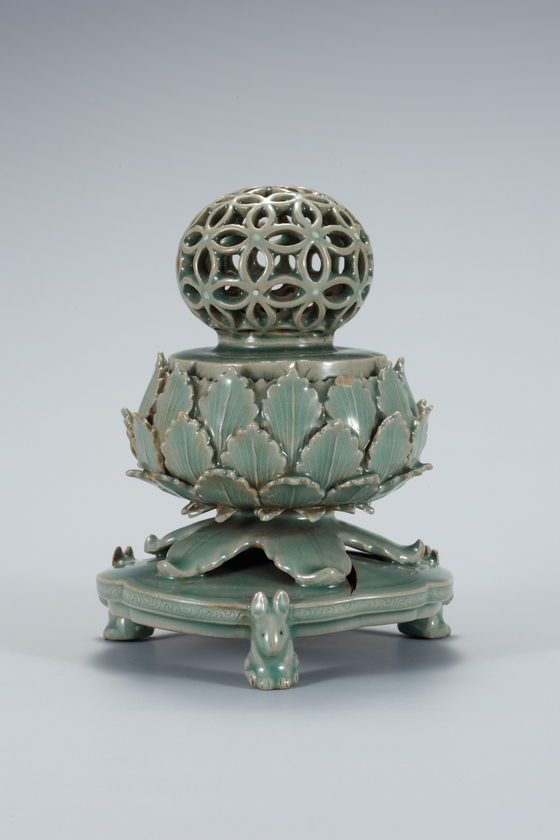Goryeo celadon takes center stage at remodeled gallery
![Celadon Jar with Inlaid Peony Design, a National Treasure, is on display at the newly remodeled Celadon Hall of the National Museum of Korea in central Seoul that opened to the public on Nov. 23. [NATIONAL MUSEUM OF KOREA]](https://koreajoongangdaily.joins.com/data/photo/2022/11/27/523a9b7a-2625-4942-b3fd-6f1a915dcae4.jpg)
Celadon Jar with Inlaid Peony Design, a National Treasure, is on display at the newly remodeled Celadon Hall of the National Museum of Korea in central Seoul that opened to the public on Nov. 23. [NATIONAL MUSEUM OF KOREA]
The mystic blue-green glaze of Goryeo celadon is so awe-inspiring that many contemporary Koreans revere the people of Goryeo (918-1392) for developing such an elegant beauty of their own in an era with no state-of-the-art kilns.
For the nearly five centuries of the Goryeo Dynasty, celadon constituted the main type of ceramic produced on the Korean peninsula. Experts say the exquisite blue-green hue typically seen in these wares is all down to the raw materials – with the presence of iron in the clay and the level of oxygen inside the kiln being the key.
![Celadon Prunus Vase with Incised Lotus and Scroll Design, a National Treasure [NATIONAL MUSEUM OF KOREA]](https://koreajoongangdaily.joins.com/data/photo/2022/11/27/2d311835-0944-40ac-98fb-0be36ac88a12.jpg)
Celadon Prunus Vase with Incised Lotus and Scroll Design, a National Treasure [NATIONAL MUSEUM OF KOREA]
Kang Kyong-nam, curator at the National Museum of Korea’s Fine Art Division says, “the word bisaek we use to refer to the color of Goryeo celadon is different to the word feise, the word that is used for similar-colored celadon from the Song Dynasty. It sounds similar, but uses different Chinese characters that mean ‘secret color.’”
The difference is evident, according to Kang, in the “Illustrated Account of the Xuanhe Embassy to Goryeo,” a travel record written by Xu Jing (1091-1153), an envoy from Song who visited Goryeo.
![The newly remodeled Celadon Hall of the National Museum of Korea exhibits some 150 pieces of celadon, including 12 National Treasures and 12 Treasures. [YONHAP]](https://koreajoongangdaily.joins.com/data/photo/2022/11/27/6b689407-6f7b-448f-8d97-82d8caaaf93c.jpg)
The newly remodeled Celadon Hall of the National Museum of Korea exhibits some 150 pieces of celadon, including 12 National Treasures and 12 Treasures. [YONHAP]
“He highly praised Goryeo celadon and its serene jade hues with a delicate sheen in his travel record,” Kang said.
To make sure visitors enjoy the true beauty of Goryeo celadon, the National Museum of Korea remodeled its celadon gallery on the third floor of the museum in central Seoul and opened it to the public last week. It’s the first makeover in nine years as its last remodeling was in 2013.
Some 150 pieces of celadon are on display, including 12 National Treasures and 12 Treasures.
“The main focus was the lighting,” said Kang, who curated the newly remodeled hall. “The lighting on every showcase is different — the angle, the intensity and so on. Meanwhile, the exhibition rooms are very dark. This is to create an immersive effect while bringing out the most beautiful bisaek of Goryeo celadon.”
In the remodeled hall, there’s a special corner called The Jade Hues of Goryeo. It’s the darkest area in the hall. As soon as visitors walk into the room, they can hear ambient music composed by Daniel Kapelian, a French media artist and producer. The music, which plays in a loop, is 15 minutes long and is titled “Blue Celadon.”
Currently based in Seoul, Kapelian is a partner at OMA Space, a Seoul-based contemporary art, design and craft studio, and served as international commissioner and curator of the Tongyeong Triennale 2022, held from March to May.

Celadon Incense Burner with Openwork Auspicious-character Design Lid, a National Treasure
Like the Quiet Room of Contemplation the museum newly opened exhibiting the two Pensive Bodhisattva from the late sixth to the early seventh centuries, Kang said the museum hopes this new space becomes another quiet space for visitors to grab some peace of mind while looking at beautiful pieces of art.
“If you’ve visited Tongyeong Triennale, you’ll know that I composed all the music there and that is how I got offered by the museum to compose ambient music for celadon,” said Kapelian, adding that his ambient music will help visitors reach deeper mindfulness inside the room as they enjoy a “very important part of Korea’s heritage and part of contemporary culture in terms of craft.”
While listening to Kapelian’s mind-soothing music, visitors are invited to look at a selection of 18 sculpted celadon objects, which includes five National Treasures. The five National Treasures are in separate showcases, with the 12th-century incense burner with a lotus blossom-shaped body and a pedestal sitting elegantly at the center.
The color isn’t all Goryeo celadon can boast. The sculptural celadon pieces enjoy a worldwide reputation for their prominent formative beauty. Goryeo potters took their motifs from a variety of objects in nature, ranging from plants and fruits to animals.
Then there’s the famous inlaid celadon, created by etching a desired pattern on the clay body of a half-dried vessel, filling the depressions with different-colored clay and then covering the vessel with celadon glaze and firing. The inlaid celadon of Goryeo flowered in the 13th century.
“Goryeo potters’ refined inlaying technique, known as Saggam, was top-notch,” said Kang. “It became their unique contribution to ceramic art.”
Though an intact piece of inlaid celadon does not exist, the exhibit also presents celadon shards from kiln sites at Yucheon-ri in Buan, North Jeolla Province, where high-grade celadon ware was produced for use in the royal household and central government offices in the capital.
On the surface of the broken pieces of celadon on display, visitors can witness engravings of “an artwork,” says Kang, “like toads resting on plantain leaves and herons loitering on the waterside, which offer glimpses of the Goryeo people’s views of nature.”
BY YIM SEUNG-HYE [yim.seunghye@joongang.co.kr]










with the Korea JoongAng Daily
To write comments, please log in to one of the accounts.
Standards Board Policy (0/250자)